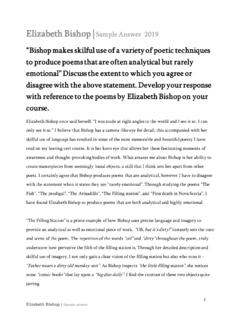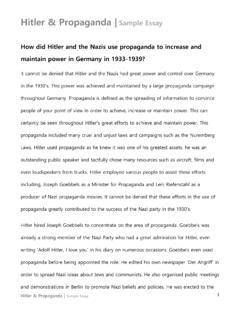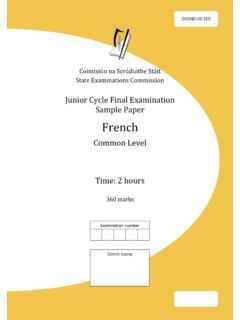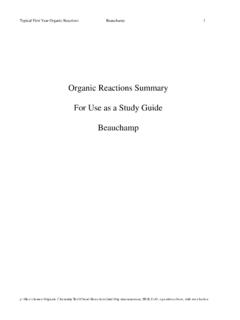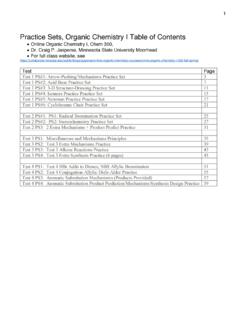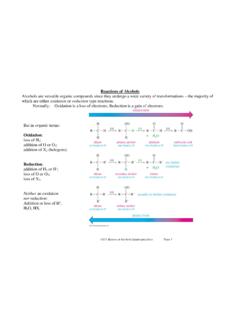Transcription of Organic Chemistry | Topic Notes
1 Organic Chemistry | Topic Notes 1 Organic Chemistry | Topic Notes Organic Chemistry is the study of compounds of carbon. A functional group is an atom or group of atoms which is responsible for the characteristic properties of a series of Organic compounds. Organic Chemistry Table Homologous Series Functional Group Structure of Group Name Example Alkane Single bond - Propane Alkene Double bond !Unexpected End of Formula Propene Alkyne Triple bond Propyne Chloroalkane H s replaced by Cl s - Cl Chloropropane Alcohol Hydroxyl - OH Propanol Aldehyde Carbonyl (end) - C=O(H) Propanal Ketone Carbonyl (middle) - C=O Propanone Carboxylic Acid Carboxyl - C=OOH Propanoic Acid Ester Bridging oxygen -COO- Methyl ethanoate 2 Hydrocarbons: Compounds that contain carbon and hydrogen only. Saturated: Contain only single bonds. Homologous Series: A series of compounds of uniform chemical type, showing graduation in physical properties with a general formula for it s members. They have a similar method of preparation.
2 Prefix No. of Carbons Meth - 1 Eth - 2 Prop - 3 But - 4 Pent - 5 Hex - 6 Hept - 7 Oct - 8 Non - 9 Dec - 10 Mike Eats Pringles But Prefers Hula Hoops On Nasty Days. Organic Chemistry | Topic Notes 3 Tetrahedral Carbon Compounds Alkanes are tetrahedral carbon compounds. These are a homologous series, most of these alkanes are fairly un reactive and are found naturally occuring. For example Methane can be made in a biomass degenerator, letting manure decay under anaerobic conditions. Methane however forms an explosive mixture with air. A hydrocarbon is a compound that contains hydrogen and carbon only. Many hydrocarbons again, are naturally occuring and have been formed in the earth over millions of years, crude oil, coal A homologous series is a series of compounds of uniform chemical type. Showing gradations in physical properties Having a general formula for all of its members Each member differs from the previous member by a CH2 unit. Tetrahedral bond angles = 109 degrees There are 3 types of tetrahedral carbon compounds on our course: Alkanes Alcohols 4 Chloroalkanes Organic Chemistry | Topic Notes 5 Alkanes - Shape: tetrahedral - never planar.
3 - Bonds: All single bonds - saturated. - General Formula: CNH2N+2 - Ending: -ane (eg: propane) CH4 - Methane C2H6 - Ethane C3H8 - Propane H H H H H H | | | | | | H -- C -- H H -- C -- C -- H H -- C -- C -- C -- H | | | | | | H H H H H H Carbon Carbon single bonds. C---C functional group They are saturated. This means that they undergo substitution reactions . This will be described later (free radical substitution and saponification). Meth - ane Eth - ane Prop - ane But - ane Pentane - ane Hex - ane Hept - ane 6 Oct - ane Non - ane Dec - ane It is important to remember 2,2,4 trimethylpentane or iso-octane and Cyclohexane as these are important in fuels. Structural isomers are compounds with the same molecular formula but different structural formula. They differ in physical properties, boiling points.
4 An example is Butane ------ Methylpropane It is important to know the use of alkyl groups when asked to form an isomer. An alkyl group is an alkane molecule from which a hydrogen atom has been removed. CH3 - methyl group C2H5 - ethyl group C3H7 - propyl group Organic Chemistry | Topic Notes 7 Alcohols A homologous series similar to alkanes but with a hydrogen replaced by an -OH (hydroxyl) group. The ending is -anol (eg: propanol). The general formula is CNH2N+1OH. There are primary, secondary and tertiary alcohols. Primary alcohols are when the carbon attached to the hydroxyl group touches one other carbon. Secondary alcohols are when the carbon attached to the hydroxyl group touches two other carbons. Tertiary alcohols are when the carbon attached to the hydroxyl group touches three other carbon. *Always indicate the position of the hydroxyl group when naming alcohols. For example 2methylbutan-1-ol which has a methyl group attached to the second carbon and the hydroxyl group is attached to the first carbon.
5 The hydroxyl group of the alcohols changes their Chemistry drastically from their corresponding alkanes. In particular, it affects their boiling points and solubility. Boiling Points 8 The hydroxyl group (-OH) undergoes hydrogen bonding, resulting in them having very strong bonds. As a result, their boiling points are higher than those of the corresponding alkanes as it takes more energy to break apart the bonds. Solubility The solubility changes as the length of the carbon chain increases. The OH group is highly polar and if the chain is short it forces the non-polar carbon chain to dissolve in polar substances such as water. If the chain becomes too long the OH group can no longer force the chain to dissolve in polar substances so it dissolves in non-polar substances instead (cyclohexane). (Like dissolves like.) -OH is the functional group. Called the Hydroxyl group. Remember - alcOHol General formula is CnH2n+1OH (alkyl + OH group) The -OH group is V shaped and the shape around each carbon atom is tetrahedral.
6 Alcohols are named by replacing the -ane from its corresponding alkane with -anol Primary Alcohol - Where the carbon atom joined to the -OH group is attached to only ONE other carbon atom. Ethanol & Methanol. Secondary Alcohol - Where the carbon atom joined to the -OH group is joined to TWO other carbon atoms. propan-2-ol Tertiary Alcohol - Where the carbon atom joined to the -OH group is joined to THREE other carbon atoms. 2methylpropan-2-ol. Organic Chemistry | Topic Notes 9 Ethanol found in alcoholic drinks is formed by fermentation, fruits with glucose have yeast added to them (catalyst=zymase), the sugar forms a solution of ethanol and carbon dioxide as a result. These kind of drinks like wine contain 10% - 12% v/v ethanol, once ethanol reaches this percentage it kills all of the yeast and fermentation stops. Therefore fermentation alone DOES NOT produce drinks greater than 12% v/v. To increase alcohol concentration, fermented liquids are distilled. Wine is distilled to brandy.
7 The distilling industry produces spirits like vodka, brandy, tequila, gin and whiskey. Uses of ethanol: alcoholic drink (consumption), fuel, solvent (such as perfumes, dyes, varnishes ). It is a good solvent because of hydrogen bonding. They have higher boiling points than their corresponding alkanes because of the highly polar -OH group giving rise to hydrogen bonding between alcohol molecules. Hydrogen bonds are stronger and require more energy to be broken. They are indefinitely insoluble in water however, the solubility decreases with the length of the carbon chain because of the insoluble alkyl portion counteracts the polar OH group making it soluble. 10 Chloroalkanes - An alkane with one or more of it s hydrogens replaced by chlorines. - Shape: tetrahedral - never planar. - Bonds: All single bonds - saturated. - Ending: Chloro-ane (eg: chloropropane) - If there are two chlorines it s di-chloro-ane, if there are three chlorines it s tri-chloro-ane, if there are four chlorines it s tetra-chloro-ane.
8 CH3Cl - Chloromethane C3H5Cl3 - 1,1,2-triChloropropane Cl H Cl H H Cl | | | | | | H -- C -- H H -- C -- C -- H H -- C -- C -- C -- Cl | | | | | | H H Cl H Cl H C2H4Cl2 - 1,1-diChloroethane Chloroalkanes are compounds in which one or more of the hydrogen atoms in an alkane molecule have been replaced by a chlorine atom. Organic Chemistry | Topic Notes 11 They are mainly used for removing oil and grease marks from machinery, in dry cleaning and chloroform was used as an anaesthetic. They aren t soluble in water but are soluble in non polar solvents such as cyclohexane. They also have low boiling points. Rarely found naturally occuring. 12 Planar Carbon Compounds: Alkenes - C = C Alkynes - C triple bond C Aldehydes - RCHO Ketones - RCOO Carboxylic Acids - RCOOH Esters - RCOOR Aromatic Compounds Alkenes - Shape: both tetrahedral and planar - tetrahedral everywhere but where the double bond is.
9 - Bonds: Unsaturated - contains a double bond. - General Formula: CNH2N - Ending: -ene (eg: propene) C2H4 - Ethene C3H6 - Propene C4H8 - Butene H H H | | | H -- C = C -- H H -- C = C -- C -- H H -- C = C -- C -- C -- H Organic Chemistry | Topic Notes 13 | | | | | | | | | H H H H H H H H H Contain Carbon Carbon double bonds. They are unsaturated which means they under go addition reactions . Replace -ane with -ene Only need to know Ethene, Propene, Butene. Ethene is the starting material from which many substances are made. Polythene, PVC, Polystyrene, synthetic rubber used to ripen fruit commercially. Note: Ethene is prepared by dehydrating ethanol, a primary alcohol. The dehydrating agent is Aluminium oxide. This is explained later. Alkynes - Shape: both tetrahedral and planar - tetrahedral everywhere but where the triple bond is.
10 - Bonds: Unsaturated - contains a triple bond. - General Formula: CNH2N-2 - Ending: -yne (eg: propyne) C3H4 - Propyne C4H6 - Butyne 14 H H H | | | H -- C C -- C -- H H -- C C -- C -- C -- H | | | H H H Contain carbon carbon triple bonds and are highly unsaturated. Replace -ane with -yne Ethyne or Acetylene is used as Oxyacetylene in fire extinguishers, welding and cutting. Water and calcium carbide form ethyne, however bubble through copper sulfate solution to get rid of impurities like phosphine, ammonia and hydrogen sulfide gas. Organic Chemistry | Topic Notes 15 Aldehydes Aldehydes and Ketones both contain the functional group C=O (carbonyl). However, in aldehydes it is positioned at the end of the carbon chain and in ketones it is positioned in the middle. As a result the first of each contains 3 carbons (prop-).




